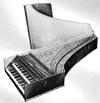- harpsichord
-
—harpsichordist, n./hahrp"si kawrd'/, n.a keyboard instrument, precursor of the piano, in which the strings are plucked by leather or quill points connected with the keys, in common use from the 16th to the 18th century, and revived in the 20th.[1605-15; < NL harpichordium (with intrusive -s- of obscure orig.). See HARP, -I-, CHORD1]
* * *
Keyboard instrument in which the strings are set in vibration by a plucking mechanism.The latter consists of plectra made of quill (or sometimes leather) mounted on vertical wooden jacks that are activated by the keys. A cloth damper touches the string when the player releases the key. It often has two parallel keyboards (or manuals) and generally has two or more sets of strings, each of which produces different tone qualities; these permit the simultaneous sounding of pitches an octave higher or lower than the note struck. The notes' loudness is not affected by the power with which the keys are struck, and there is no way to sustain a note after the key is released. Primitive harpsichords existed by the mid-15th century. In the 17th–18th centuries the harpsichord became a very important solo, accompanimental, and ensemble instrument. From с 1750 the pianoforte, with its greater dynamic capacity, began to displace it, and by 1820 the harpsichord had largely vanished. It was revived in the late 19th century by scholars, performers, and instrument builders. Harpsichord with soundboard by Hans Ruckers, Amsterdam, 1612From the National Trust Property, Fenton House, Hampstead, London; by gracious permission of Her Majesty Queen Elizabeth, the Queen Mother
Harpsichord with soundboard by Hans Ruckers, Amsterdam, 1612From the National Trust Property, Fenton House, Hampstead, London; by gracious permission of Her Majesty Queen Elizabeth, the Queen Mother* * *
keyboard musical instrument in which strings are set in vibration by plucking. It was one of the most important keyboard instruments in European music from the 16th through the first half of the 18th century.A brief treatment of harpsichords follows. For full treatment, see keyboard instrument: The harpsichord (keyboard instrument).Generally, the harpsichord has two or more sets of strings, each of which produces different tone qualities. One set may sound an octave higher than the others and is called a 4-foot register, whereas a set of strings at normal pitch is called an 8-foot register. In some 20th-century harpsichords, a 16-foot register, sounding an octave lower, is added, but this addition was extremely rare in old harpsichords. Two sets of 8-foot strings may produce distinct tone quality because they are plucked at different points or with plectra of different material.The tone of the harpsichord is amplified by a soundboard placed beneath the horizontal plane of the strings, which pass over a bridge that is glued to the soundboard and that transmits their vibration to it. The plucking mechanism consists of sets of jacks, thin vertical strips of wood that rest on the far ends of the keys and pass through a lower fixed guide and an upper slide, or movable guide; the slide moves a given set of jacks either slightly toward or slightly away from its set of strings, depending on whether that set is to be used or unused. A pivoted tongue at the top of each jack is pierced in its upper half to take a plectrum of quill or leather and is held upright by a spring of wire or bristle. A cloth or felt damper completes the jack; this quiets the string when the key is released and the plectrum falls beneath the string.The earliest surviving harpsichords were built in Italy in the early 16th century. Little is known of the early history of the harpsichord, but, during the 16th–18th century, it underwent considerable evolution and became one of the most important European instruments. National schools of construction arose, notably in Italy, Flanders, France, England, and Germany; and highly decorated cases with painted lids became fashionable. Most of the great Baroque composers played or wrote for the harpsichord. By the middle of the 18th century the harpsichord had grown to a normal compass of five full octaves, three or more sets of strings and jacks, and often two keyboards. At this time it began to compete with the new pianoforte, which was capable of playing soft or loud according to the fingers' pressure on the keys. The harpsichord is incapable of this dynamic gradation and was overwhelmed in popularity by the piano. The harpsichord was revived in the late 19th century, and it continues to evolve—but not necessarily to improve—in the hands of modern builders and composers. See also clavicytherium; spinet; virginal.* * *
Universalium. 2010.
